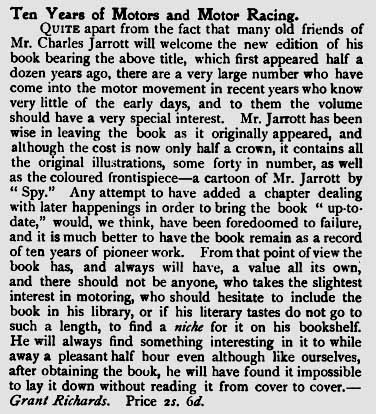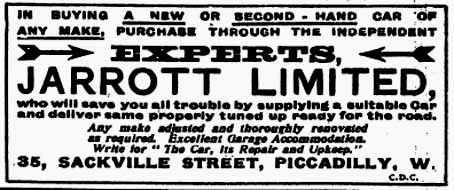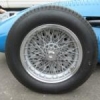
The wit and wisdom of Charles Jarrott
#1

Posted 27 May 2003 - 09:59
Of course I have always known that '10 Years of Motors and Motor Racing' was an essential book for anyone interested in the period, but it is not exactly bargain-basement price, and with so many other demands on my hard-earned and meagre income, I never got round to buying it. Until now.
What a brilliant book! Positively the best book on motor racing I have ever read (sorry Doug, Karl, and other authors amongst us). Superbly written, full of passion and wit - some of it reaching the laugh-out-loud level (how many books can do that?), as well as a unique insight into what it was actually like to 'be there'.
The trashing of the hotel room during the Paris-Vienna race reads like a scene from 'Spinal Tap'. Reminded me of a pit stop in a modern-day GP. Not!
The impromptu 'village sports day' durring the Paris-Bordeaux is both hillarious and charming. What comes over throughout the book is Jarrotts's love of driving and of the sport. Could any GP dirver today write like this?
Just a couple of my favourite quotes:
For those who think that the beginning of the end of motor racing was when Colin Chapman put Gold Leaf stickers on his cars:
"Above all, it is evident that racing is rapidly being reduced to a business. The firm with the most money makes the most elaborate arrangements, and places the drivers of its cars at a corresponding advantage...... there can be no question that the general result of making the matter of driving a question of £.s.d. is bad for the sport, and will no doubt result, as a like principle has resulted in other sports, in killing public intetrest."
And one that should be printed out and placed in my own somewhat tempremental vehicle:
"Personally I used to become depressed if my car went particularly well, because this always preceded some grand catastrophe. In the ordinary way one would only have some small things happen, such as a gear wheel breaking up, a platinum tube bursting, a tyre puncturing, or the motor refusing to start. But if the car went exceptionally well for, say, twenty miles, something terrible was sure to happen afterwards, either the crank shaft would break, the gear box fall out, or a wheel come off. Hence, when one's car took it into its head to travel exceedingly well, a wise precaution was to send off a wire stating one would not be home for two or three days."
I feel sure that Mr Jarrott would be delighted to know that, over 100 years later, there are still those intrepid motorists amongst us for whom travelling hopefully is a more pleasent (and much more frequent) experience than actually arriving.
Advertisement
#2

Posted 27 May 2003 - 12:48
"Suddenly my car stopped. It was 11 o'clock at night, and I got down and commenced to investigate the trouble... While I was looking round the car of course a crowd collected, and a big fellow of the 'loafer' type, leaning over the car, discovered my bull pup sleeping peacefully...The discovery was followed by pushing the dog about...I naturally resented this and requesed that my dog should be left alone. This was immediately followed by a repetition of the incident, and I then expostulated in more emphatic language. Then, without warning, the loafer made a rush round the car, and before I realised what was happening I was engaged in a desperate set-to, having the knowledge that if I once went down I would in all probability be kicked to death... (the police appeared in the nick of time but Jarrott concludes...)...I still remember the terrific swing of that loafer, which, had it once got home, would probably have ended my motoring career..."
What's so commendable here is that Jarrott the gent was not making himself the hero of the piece - had this been S.F. Edge I'm pretty sure he would have told an heroic tale of having heroically given the loafer a sound thrashing and a lesson the fellow would never forget. Jarrott's memoirs at least have an edge of humility largely lacking from most writings of the time, as in Graham White and H.O. Duncan. It is great stuff.
DCN
#3

Posted 16 January 2009 - 16:55
It's interesting in comparison with the autobiography of Lord Brabazon of Tara, which talks more about his aviation exploits. I did giggle at the 'what ho boys own' style of 'The Brabazon Story' in which he mentions that he has two sons, but never mentions their names
#4

Posted 16 January 2009 - 17:26
Tavistock Chambers, Bloomsbury
Charles A JARROTT (unmarried) 25 Manager Automobile Co., born Newport Wales
However, there is no birth registration for such a person in Wales ... the 1881 census has
Charles JARROTT aged 4 - birthplace not given, living in Bloomsbury. His mother was born in Newport. Has father was
Robert JARROTT 42, Fitter at Builders, born Wingrave Bucks. In 1891 and 1901 he (Robert) was a Blacksmith.
Possible birth registration
Births Jun 1877
JARROTT Charles, St. Geo. H. Sq. 1a 372
#5

Posted 16 January 2009 - 18:46
b. 26 March 1877 Pimlico, London
d. 04 January 1944 (66 years old)
#6

Posted 16 January 2009 - 19:22
#7

Posted 17 January 2009 - 20:08
Thanks for the details on him. He seems to have been an engaging character from the book. Funny how he seems to have had such a low profile after the book was published.
#8

Posted 17 January 2009 - 20:30
Originally posted by Andrew Stevens
Married the wife of an Earl? I assume the Earl was no longer in the picture at that stage....
Thanks for the details on him. He seems to have been an engaging character from the book. Funny how he seems to have had such a low profile after the book was published.
Violet VYNER married James F.H. ERSKINE (5th Earl of Rosslyn) in 1890, then married Charles JARROTT in 1903. (Divorce in 1902)
http://www.thepeerag...1467.htm#i14662
#9

Posted 17 January 2009 - 20:52
Sounds a lot like Charles ....;)
#10

Posted 17 January 2009 - 21:28
Originally posted by Vitesse2 (in 1895 or 1896!), Sounds a lot like Charles ....;) [/B]
Still in his teens then!
#11

Posted 18 January 2009 - 09:50

by 1914 they were listed as "Motor car manufacturers. Representatives and agents for the Crossley, de Dietrich and Sizaire cars"
#12

Posted 18 January 2009 - 10:12
#13

Posted 18 January 2009 - 15:38
According to his death notice in The Times of January 7th 1944, he was to be cremated at Golders Green Crematorium that day. No indication where (or if) the ashes would be interred.Originally posted by speedman13
Does anyone know where Charles Jarrott is buried.
edit: his wife survived him by just over a year, dying on Feb 17th 1945 at Oaklea, Wimbledon Park SW19.
#14

Posted 19 January 2009 - 08:44
Here’s a little bit on his pre and post racing career:
“He began motoring in 1896 and witnessed the London to Brighton run (14 November 1896) to celebrate the emancipation of the motor car following the passage of the Light Locomotives Act. In 1897 he became secretary to the Motor Car Club, the organizers of the run. After giving up the law, he entered the motor trade and formed the English De Dion Bouton Co. in 1899, visiting the USA to report on the machines being manufactured there. In 1900 he went into partnership with Harvey du Cros in the English Panhard Levassor Motor Co., and in 1902 with William Malesbury Letts formed Charles Jarrott and Letts Ltd, sole agents for De Dietrich and Oldsmobile, as well as selling Crossley and Bugatti cars. He retired from the partnership in 1909.”
“His holy grail was the open road. After being fined £5 by Lincolnshire magistrates in 1898 for driving a motor vehicle in excess of 12 m.p.h., he became one of the leaders of the movement to protect motorists from what he regarded as legal persecution by ‘horsey’ JPs and police who used ‘unEnglish’ methods against them. He organized cycle patrols to warn motorists of police speed traps on the London to Brighton road, and was a founder in 1905 of the Automobile Association. In 1922 he succeeded Sir William Joynson-Hicks to become the association's third chairman, but resigned in 1924 over the failure of the planned amalgamation with the Royal Automobile Club, of which he had also been a member since its foundation. He was an officer of several other motoring bodies, and was a founder of the Olympia motor show. A founder member of the Royal Aero Club, he was inspector of transport for the Royal Flying Corps during the First World War, and held the rank of lieutenant-colonel; he was mentioned in dispatches three times and appointed OBE in 1918.
From 1935 until his death Jarrott was general secretary of the Royal Society of St George. He died of bronchopneumonia in St Stephen's Hospital, Chelsea, London, on 4 January 1944, and was cremated at Golders Green”
#15

Posted 24 January 2009 - 06:50
At a Veteran Car Club event in Canberra in 1965, met Ken Watson from Cootamundra NSW, who had photos of a Jarrott car he had started to restore. This was easily recognised as identical to the 4 cyl Type 31 Napier. Henry Formby and I made a detour to visit Ken on the way home. It was certainly 1910 Napier with different name on the radiator and the pedals, and Ken was doing superb restoration on the mechanicals,-- as you would expect from a rebuilder of engines for light aircraft. He had salvaged some remains from a second Jarrott, which had come to rest way out towards Broken Hill; and Ken said it had been a taxicab.
Now where my 1911 Type 38 Napier came from, there were also remains of a 1910, and I was able to give him a good useable crankshaft and conrods which he desperately needed, and perhaps other items that I did not commit to memory.
Unfortunately Ken did not finish the restoration before he was beyond restoration; but the present ownership of the car would certainly be known to Bill Bishop and Peter Shannon.
Now, how and why was Napier able to build re-labelled Napiers for Jarrott while under a binding agreement to supply only S F Edge? Venables indicates that considerable distrust and dissatisfaction had developed between Napier and Edge some time before the arrangement was ended; and much apparently arose from increasing margins on sales taken by Edge while Napier's profit per car declined. And there is some suggestion that Napier may have assumed the right to build trucks to sell independantly, (though it seems that apart from quality and inventiveness in their products, none of the three generations of Napier had great interest or aptitude for marketing.)
(It is irrelevant to Jarrott, but I know a few things about Andrew Lang, who flew a DH7 to 30,500 ft in just over an hour in January 1919, and used the pen name of "Napier Lion" afterwards. He must have been tough. It would have been perishing cold at that altitude over France in winter in an open cockpit plane.)
Ivan Saxton
#16

Posted 25 January 2009 - 18:23
Written in 1906, or was it 2006???
#17

Posted 07 September 2009 - 14:29
I am writing my own book about the Edgehill Inquest, in itself a fascinating insight into early motoring - comments and contributions gratefully received!
#18

Posted 10 September 2009 - 07:34




 This is the 100mm bore x 250mm stroke engine. Three of these cars were made, one selling recently at 170k Euros.
This is the 100mm bore x 250mm stroke engine. Three of these cars were made, one selling recently at 170k Euros.
#19

Posted 11 February 2016 - 20:42
I was googling the google books link for this book and this thread came up. Just figured I would take a moment to point out, that, at least US IP addresses have free access to it.
It's an *amazing* read. It was the book that ignited an interest in a much earlier period of motorsport for me.
https://play.google....id=iPRKAAAAYAAJ
"No one seemed to be very clear as to how this extraordinary change was to take place suddenly; nevertheless, there was the idea that the change was to be a rapid one" -- Jarrott, with substantial insight, on the future impact of the motorcar.
EDIT was to add link and quote.
Edited by GPevolved, 11 February 2016 - 20:45.
Advertisement
#20

Posted 12 February 2016 - 06:54
I must admit I had not seen this thread before but I have been recommending Charles Jarrot's "Ten Years Motors and Motor Racing" to people since I first obtained a copy nearly sixty years ago
.It was reprinted in the 1950s and this was the copy I had.
It took me about another twenty years to locate a 1906 first edition which is the cornerstone of my library.
Read that book and then realise how easy it is today to drive a racing car.
Because of that book I persuaded a friend of mine to come with me on a drive from Paris to Madrid in a car with the same top speed as Jarrot;s car in that race. Sadly a French lady schoolteacher rushing to get to school hit us and destroyed out car.
Our average speed on modern roads, admittedly with traffic, was running lower than Jarrot had achieved in 1903 in a hulking great two ton car.
It is still to me the most evocative motor racing book ever written.
#21

Posted 12 February 2016 - 06:57
It took me about another twenty years to locate a 1906 first edition which is the cornerstone of my library.
Graham: I am extremely jealous. On the one hand, I am glad materials such as these are being digitized for the next generation of motorsport history enthusiasts. On the other hand, I would love to have a first edition copy in my modest library.
#22

Posted 12 February 2016 - 13:06
Digital was the only way I could get to read this splendid work
Try: http://www.retroread...rott-ebook.html
#23

Posted 31 July 2019 - 13:07
Jarrott's "Ten Years of Motors and Motor Racing":
http://carsandracing...motorracing.php
and a review from the Automotor Journal/1912:
#24

Posted 31 July 2019 - 17:00
"...there should not be anyone, who takes the slightest interest in motoring, who should hestitate to include the book in his library..."
Definitely the case, even if it's now difficult to track down a copy for 2s 6d.
#25

Posted 15 August 2019 - 08:56
In 1912, Charles Jarrott was involved in a Sizaire-et-Naudin agency,
a Lorraine-Dietrich agency,
and sold second-hand cars:



#26

Posted 14 January 2024 - 03:54
My favorite book in my entire collection.

















